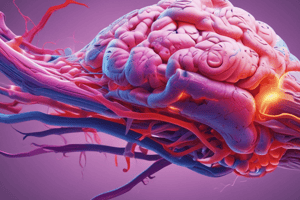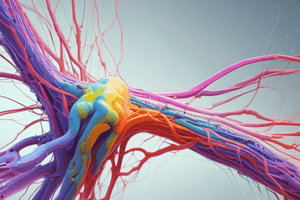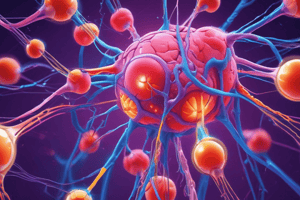Podcast
Questions and Answers
Which chemical transmitters are associated with pain responses from tissue injury?
Which chemical transmitters are associated with pain responses from tissue injury?
- Histamine (correct)
- Serotonin
- Acetylcholine
- Epinephrine
What reaction is likely stimulated by severe pain?
What reaction is likely stimulated by severe pain?
- Sympathetic changes like hypotension
- Parasympathetic changes like hypotension (correct)
- Sympathetic changes like bradycardia
- Parasympathetic changes like tachycardia
Which type of pain is likely to be poorly localized and dull aching?
Which type of pain is likely to be poorly localized and dull aching?
- Visceral pain (correct)
- Superficial somatic pain
- Cutaneous pain
- Deep pain (correct)
What type of fibers are associated with cutaneous pain?
What type of fibers are associated with cutaneous pain?
Which symptom is associated with autonomic reactions to mild pain?
Which symptom is associated with autonomic reactions to mild pain?
What is a common emotional response to pain?
What is a common emotional response to pain?
Which statement is true about visceral pain?
Which statement is true about visceral pain?
What distinguishes superficial somatic pain from deep somatic pain?
What distinguishes superficial somatic pain from deep somatic pain?
What is the primary function of pain as described in the content?
What is the primary function of pain as described in the content?
Which type of stimuli can lead to the activation of pain receptors?
Which type of stimuli can lead to the activation of pain receptors?
Where are the cell bodies of pain receptors primarily located?
Where are the cell bodies of pain receptors primarily located?
Which of the following substances is NOT typically a pain-producing substance?
Which of the following substances is NOT typically a pain-producing substance?
What term is used to describe receptors that do not adapt to sustained stimulus?
What term is used to describe receptors that do not adapt to sustained stimulus?
What pathway does the pain signal take from the spinal cord to the brain?
What pathway does the pain signal take from the spinal cord to the brain?
What is the role of sensitized nociceptors in response to tissue injury?
What is the role of sensitized nociceptors in response to tissue injury?
Which of the following statements is correct regarding the transmission of pain signals?
Which of the following statements is correct regarding the transmission of pain signals?
Which statement best describes referred pain?
Which statement best describes referred pain?
What mechanism explains the perception of pain in both the skin and viscera?
What mechanism explains the perception of pain in both the skin and viscera?
Which area is most likely to experience referred pain from the heart?
Which area is most likely to experience referred pain from the heart?
Which structure is NOT involved in the pain pathway to the brain?
Which structure is NOT involved in the pain pathway to the brain?
What role does the thalamus play in the perception of pain?
What role does the thalamus play in the perception of pain?
What is one result of the reflex contraction of overlying muscles in response to pain?
What is one result of the reflex contraction of overlying muscles in response to pain?
Which type of nerves transmit the pain signals from the skin to the spinal cord?
Which type of nerves transmit the pain signals from the skin to the spinal cord?
In which dermatome is referred pain from the appendix most commonly felt?
In which dermatome is referred pain from the appendix most commonly felt?
What characterizes pain that serves a protective function?
What characterizes pain that serves a protective function?
What type of nerve fibers are pain receptors primarily composed of?
What type of nerve fibers are pain receptors primarily composed of?
Where are pain receptors most abundantly located in the body?
Where are pain receptors most abundantly located in the body?
What type of pain is characterized as unpleasant sensory and emotional experience?
What type of pain is characterized as unpleasant sensory and emotional experience?
Which statement is true regarding the distribution of pain receptors?
Which statement is true regarding the distribution of pain receptors?
Which of the following best describes the free nerve endings that function as pain receptors?
Which of the following best describes the free nerve endings that function as pain receptors?
What is the primary role of nociceptors?
What is the primary role of nociceptors?
What types of behaviors are typically associated with pain responses?
What types of behaviors are typically associated with pain responses?
Flashcards
Sympathetic Pain Response
Sympathetic Pain Response
Pain signals travel through the sympathetic nervous system, causing increased heart rate, blood pressure, and respiration.
Parasympathetic Pain Response
Parasympathetic Pain Response
Pain signals travel through the parasympathetic nervous system, causing decreased heart rate and blood pressure.
Fast Pricking Pain
Fast Pricking Pain
Sharp, quick pain that travels through myelinated A-delta fibers, well localized in the skin.
Slow Burning Pain
Slow Burning Pain
Signup and view all the flashcards
Cutaneous Pain
Cutaneous Pain
Signup and view all the flashcards
Deep Pain
Deep Pain
Signup and view all the flashcards
Visceral Pain
Visceral Pain
Signup and view all the flashcards
Superficial Somatic Pain
Superficial Somatic Pain
Signup and view all the flashcards
What is pain?
What is pain?
Signup and view all the flashcards
Protective function of pain
Protective function of pain
Signup and view all the flashcards
Types of pain stimuli
Types of pain stimuli
Signup and view all the flashcards
What are pain receptors?
What are pain receptors?
Signup and view all the flashcards
Distribution of pain receptors
Distribution of pain receptors
Signup and view all the flashcards
Activation of pain receptors
Activation of pain receptors
Signup and view all the flashcards
Adaptability of pain receptors
Adaptability of pain receptors
Signup and view all the flashcards
Chemical stimulation of pain receptors
Chemical stimulation of pain receptors
Signup and view all the flashcards
What is referred pain?
What is referred pain?
Signup and view all the flashcards
How is referred pain explained?
How is referred pain explained?
Signup and view all the flashcards
What is the convergence projection theory?
What is the convergence projection theory?
Signup and view all the flashcards
Why does the skin feel the pain in the convergence projection theory?
Why does the skin feel the pain in the convergence projection theory?
Signup and view all the flashcards
What is the facilitation theory?
What is the facilitation theory?
Signup and view all the flashcards
What is a dermatome?
What is a dermatome?
Signup and view all the flashcards
How is heart pain referred?
How is heart pain referred?
Signup and view all the flashcards
How is appendix pain referred?
How is appendix pain referred?
Signup and view all the flashcards
How are pain receptors activated?
How are pain receptors activated?
Signup and view all the flashcards
Do pain receptors adapt?
Do pain receptors adapt?
Signup and view all the flashcards
What are pain-producing substances (PPS)?
What are pain-producing substances (PPS)?
Signup and view all the flashcards
Explain the convergence projection theory.
Explain the convergence projection theory.
Signup and view all the flashcards
Explain the facilitation theory.
Explain the facilitation theory.
Signup and view all the flashcards
Study Notes
Pain Physiology
- Pain is an unpleasant sensation caused by noxious stimulation of sensory nerve endings due to actual or potential damage.
- Pain has a protective function, initiating the withdrawal reflex.
- Pain can be produced by mechanical, thermal, or chemical stimuli leading to tissue damage.
Pain Receptors
- Pain receptors are free nerve endings with cell bodies in spinal ganglia (body) and trigeminal nerve ganglia (face).
- They are widely distributed, particularly in the skin.
- Nociceptors respond to various stimuli when their intensity reaches a noxious threshold.
- They are non-adapting receptors, meaning they continue to respond as long as the stimulus persists.
Mechanism of Pain Receptor Stimulation
- Pain receptors are stimulated chemically by substances released from damaged tissue.
- Examples of pain-producing substances (PPS) include bradykinin, histamine, serotonin, acids, excess K+ ions, and prostaglandins.
Mechanisms of Pain Receptors
- Nociceptive pain involves thermal, chemical, and mechanical stimuli.
- The DRG (dorsal root ganglion) carries pain signals to the spinal cord.
Mechanism of Pain
- Tissue injury releases substances like prostaglandins, bradykinin, and leukotrienes.
- These substances sensitize nociceptors.
- Sensitized nociceptors release neurotransmitters like aspartate, neurotensin, glutamate, and substance P.
- These neurotransmitters transmit pain signals to the brain via the dorsal horn.
Reactions Associated with Pain
- Autonomic reactions: Mild pain stimulates the posterior hypothalamus triggering sympathetic changes (tachycardia, increased blood pressure, pupillary dilation, increased respiration). Severe pain stimulates the anterior hypothalamus triggering parasympathetic changes (bradycardia, hypotension).
- Motor reactions: Withdrawal reflex and reflex contraction of overlying muscles (deep somatic and visceral pain).
- Emotional effects: Crying, anxiety, and depression.
Quality of Pain
- Fast pricking pain is carried by A delta fibers and is immediate, short-lasting, and sharp.
- Slow burning pain is carried by C fibers and follows fast pain, lasting longer, and is described as burning.
Pain Localization
- Well-localized pain originates from the skin; it is transmitted through the sensory cortex.
- Poorly localized pain originates from subcutaneous tissues and viscera; it is transmitted through the thalamus.
- Glutamate is the chemical transmitter for well-localized pain, while substance P is for poorly localized pain.
Types of Pain
- Cutaneous pain: Arise from the skin, transmitted by thin myelinated A delta fibers.
- Deep somatic pain: Arise from muscles, ligaments, and joints; transmitted by non-myelinated C fibers; characterized as dull and aching, poorly localized.
- Visceral pain: Arise from internal organs; transmitted by non-myelinated C fibers and autonomic fibers; also poorly localized and dull and aching.
Pain Pathway
- Pain signals travel from nociceptors to the posterior somatosensory cortex, where quality and location are determined.
- The pathway involves the spinal cord, thalamus, and other brain regions like the midbrain, pons, reticular formation, and medulla.
Referred Pain
-
Pain is referred to the dermatome supplied by the same dorsal nerve roots as the diseased structure.
-
Referred pain is explained by two theories:
- Convergence projection theory: Pain fibers from the skin area and diseased viscera converge on the same second-order neuron, leading the brain to perceive the pain as originating from the skin. Diagram of the convergence projection theory is included.
- Facilitation theory: Visceral pain fibers send collaterals to facilitate the second-order neuron of the pain pathway from the skin, leading to pain perception in the skin area. Diagram of the facilitation theory is included.
-
Examples of organs and their referred pain locations
Studying That Suits You
Use AI to generate personalized quizzes and flashcards to suit your learning preferences.




